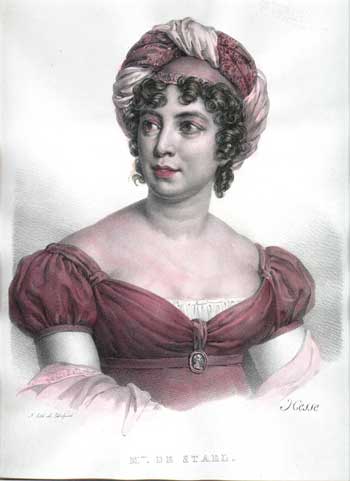Liberty Matters
The Importance of Constitutions and Political Institutions

Thus far, our discussion has focused primarily on Germaine de Staël's analysis of moeurs, of the sentiments and dispositions that she believed were critical if France was to weather the storm of the Revolution and to become a stable regime. This has led to a productive consideration of central dimensions of her political stance: her fear of "fanaticism;" her belief that pity, generosity, and "enthusiasm" were important sentiments; her desire to embrace a cosmopolitan orientation; and her distance from Machiavellian politics. I'd like to add another element to the mix: the importance of political and juridical institutions and of the constitutions that could provide the framework for their instantiation and survival.
Like her father, Jacques Necker, and like her lover during the 1790s, Benjamin Constant, Staël favored a constitutional regime that protected civil liberties and provided a space where political differences and divergent interests could be debated and, hopefully, compromised. One of the constitutions that were of special concern to her was the constitution that created the Directory Government (1795-1799). This constitution was debated in the Convention during the summer of 1795, accepted by this body on August 22, approved in a national plebiscite in September, and put into effect on October 26. This 1795 constitution retained the fundamental features of the 1789 Declaration of the Rights of Man and Citizen and of the Constitution of 1791: protection of civil liberties, popular sovereignty, political authority exercised by elected officials, an independent judiciary, rule by law, and the sanctity of property. It also was designed to avoid the danger of dictatorship by one committee or one institution. (The memory of the power of the Committee of Public Safety during the Terror was strong among the "Thermidorians" who wrote the Constitution.) Staël and her father were unhappy that the Constitution lacked provisions for more coordination of, and checks between, the executive and legislative bodies – that is, they wanted more provisions for a "balance of power."[112] Nonetheless, she was generally supportive, relieved that an institution as radical as the Convention had pushed through such a reasonable constitution. France, she believed, was moving in the right direction. This was true even though she was forced into exile at this time due to her close association with former nobles and émigrés.
Juridical and constitutional issues remained important for Staël. These were the years when she and Constant were connected romantically and intellectually. Constant was working on a manuscript, unpublished until 1991, now entitled Fragments d'un ouvrage abandonné sur la possibilité d'une constitution républicaine dans un grand pays.[113] At the same time, Staël was working on a manuscript, which would also be unpublished at the time, entitled Des circonstances actuelles qui peuvent terminer la Révolution et qui doivent fonder la République en France.[114] Both works were centrally concerned with constitutional issues, and both have been viewed by scholars as essentially joint projects. The point to emphasize is that both were concerned with more than human character, sensibilité, and moeurs; they also focused on the constitutional-institutional framework essential for a liberal society.
Given the state of American politics, it is perhaps not surprising that our own conversation has focused primarily on culture – the lamentable decline of civil discourse, the need to encourage generous "dispositions of the soul." However essential this is, though, it is important to restate the obvious: namely, that a successful liberal order also requires appropriate institutional structures. In Staël's era, liberals were facing crises on both fronts – institutional and cultural – and the instabilities created by the torrent of the French Revolution culminated in the rise to power of a tyrant, Napoleon. We can only hope that, in the United States, as civility declines, the legal and constitutional institutions will prove sufficiently robust to resist such an outcome.
Endnotes
[112.] At the time, there was a vigorous debate concerning the details of the Constitution of 1795, a debate that has continued in subsequent scholarship. For a review of this debate, see: 1795: Pour une République sans Révolution, sous la direction de Roger Dupuy et Marcel Morabito (Rennes: Presses Universitaires de Rennes, 1996); and, Constitution de l'an III: Boissy d'Anglas et la naissance du libéralisme constitutionnel, sous la direction de Gerard Conac et Jean-Pierre Machelon (Paris: PUF, 1999).
[113.] Benjamin Constant, Fragments d'un ouvrage abandonné sur la possibilité d'une constitution républicaine dans un grand pays, edited by Henri Grange (Paris: Aubier, 1991). Composed mostly between 1798 and 1803 (when Constant and Staël were together), and finished in 1807 or 1808, it was unpublished until 1991.
[114.] Madame de Staël, Des circonstances actuelles qui peuvent terminer la Révolution et qui doivent fonder la République en France, ed. Lucia Omacini (Genève: Droz, 1979).
Copyright and Fair Use Statement
“Liberty Matters” is the copyright of Liberty Fund, Inc. This material is put on line to further the educational goals of Liberty Fund, Inc. These essays and responses may be quoted and otherwise used under “fair use” provisions for educational and academic purposes. To reprint these essays in course booklets requires the prior permission of Liberty Fund, Inc. Please contact oll@libertyfund.org if you have any questions.